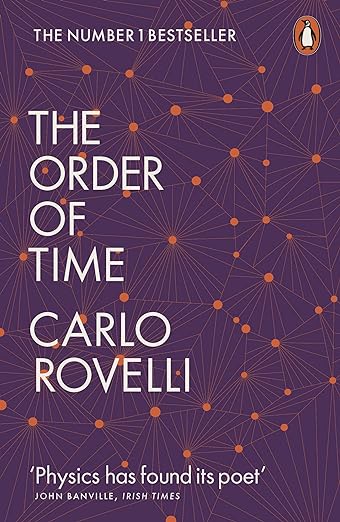


時間は存在しない (Time doesn’t exist)
by Carlo Rovelli
書評「めぐりあう書物たち」 (Book review ”Book come across”)
by 尾関章 (Akira Ozeki)
Last week, I talked about how physics doesn’t require time. The book he read was “Time Doesn’t Exist” (written by Carlo Rovelli, translated by Sei Tominaga, published by NHK Publishing in 2019). Since it was written by a theoretical physicist, it cannot be dismissed as some sort of nonsense. At least I was satisfied.
The heart was something like this. When things change, we describe the change as a function of the time variable t. “T” is like the hands of a clock. In other words, in our daily lives, we relate changes in things to changes in the clock.
However, the author argues that the person to be associated does not have to be a watch. It does not have to be a guideline for a day, month, or year like the rotation of the Earth, the revolution of the Moon, or the revolution of the Earth. If you relate one change to another change, you can create a physical equation.
I see. In that case, it may be safe to say that “time does not exist.” But there’s a trick here. It is hidden in the word “change”. When we say things change, we think of time. Getting rid of “t” does not mean getting rid of time.
Let us recall philosopher John Ellis McTaggart’s theory of time, which we discussed in this column the other day. This also referred to the “unreality of time.” However, in the process of proving this, he also taught me that there is an aspect of time that cannot be expressed with the letter “t”.
According to McTaggart, time can be divided into three series: A, B, and C. Both series A and B are important; series A focuses on the “distinction between past, present, and future,” and series B focuses on “the distinction between earlier and later.” Neither of these two points of view can fit within the “t” frame.
As for the A series, in this world a change is occurring in which future events turn into present events, and then eventually become past events. This change cannot be explained only by the time axis representing “t”. On the other hand, the B series is a bit more complicated. “Before and after” are easy to fit into the image of a time axis. However, why do we view the negative direction as “before” and the positive direction as “later”? There is something about time that cannot be measured by the number of “t”s.
What we can say from the above is that although the world exists without the time variable “t”, we still recognize that there is time in the world. This is another theme of this book, “Time Doesn’t Exist,” and is explained in detail later in the book. This week, let’s focus on that.
The keyword here is “blur”. “The existence of time is deeply connected to blurring,” the author declares, “blurring occurs because we are unaware of the microscopic details of this world.” He says that time is nothing but a manifestation of human ignorance.
When I hear this story, people like me, who studied physics in my student days, feel like I understand that he is talking about entropy. Entropy is a numerical value that appears in thermodynamics and statistical mechanics. I remember that in the lecture, it was explained as “the total amount of information that has been lost.”
Let’s take a glass of water as an example. What we are looking at is the “macroscopic state” of liquid water in a transparent container. There are countless water molecules in water, each in a variety of positions that are difficult to distinguish. This blurring is entropy. The author explains that the value of entropy is determined by the number of configurations that are indistinguishable to us, based on the theory of Austrian physicist Ludwig Boltzmann.
In physics, there is a “law of increasing entropy” (the second law of thermodynamics), which states that entropy only increases. It refers to a situation where the documents stacked neatly on a desk suddenly turn into a pile of disorganized paper. There, an “orderly arrangement” changes to a “chaotic arrangement.” This is not just about paper documents. The author sees the state of the universe as “a gradual process of disorder, like a deck of cards being shuffled out of order.”
What is interesting is that this book uses entropy to explain the difference between the past and the future. According to the author, the past “leaves its traces in the present.” Craters on the moon, fossils of ancient creatures, and memories in the brain are nothing but such “traces.” So, why are there traces of the past but no traces of the future? According to the authors, this is due to “low entropy in the past.” He says he cannot find anything else that “creates the difference between the past and the future.”
I wonder if it’s true. This seems to be related to the law of conservation of energy. Traces are created when something stops moving and kinetic energy turns into thermal energy, like when a meteorite hits the moon and creates a crater. Since the change to heat is disordered, it progresses over time. In this way, the traces can be seen after the fact. Future events will also leave traces, but they cannot be confirmed in advance at the present moment.
According to the author, the reason we feel that the past is “fixed” is because there are many traces. As a result, the brain develops an “extensive map of past events,” and is bound to that past. In contrast, in the future, there are no visible traces, so there are many options.
Now that we’ve come this far, let’s review last week’s story again. According to this book, the world is made up of a network of events. Therefore, it can be described by the relationships between many variables. In fact, this week’s story is not unrelated to this world image.
According to this book, we “belong” to “parts” of the world. What it means to be a part is that the variables that interact with us are not all variables. It is a position that believes that humans are not concerned with the world as a whole, but only with a part of it.
This affects entropy. Entropy reflects the degree of “blurring,” but the degree of blurring depends on “which variables we interact with.” “Which variables interact with” differs from part to part, so the degree of “blurring” also depends on the part to which you belong. So where are we humans? The authors explain that the images are placed in areas where “entropy when the world began” “appears to have been extremely low.”
The author understands the state of low entropy in the early universe as follows. “The universe is not arranged in a special way.” “We belong to a special physical system, and the state of the universe related to that physical system is special.” – Here, “physical system” refers to It’s about the parts.
I think this view is closely related to the anthropic principle of cosmology. The anthropic principle holds that the universe is the way it is because otherwise humans could not exist. The author’s view of time is similar to this, and seems to be saying that the reason why time flows in this way in the universe is because humans would not be able to sense time otherwise. You could say that we happen to be in a part of the universe where time flows like this.
There is one more thing I would like to add about “parts”. The author connects the meaning of “perspective” to “interacting with a small portion of the countless variables in the universe.” Since we see the universe “from within,” we cannot describe the world without a “perspective.” What cannot be ignored are words such as “now,” “here,” and “me,” which change their designation depending on the situation…This thesis reminded me of McTaggart’s theory of time.
The translator’s “Appendix” to “The Unreality of Time” (written by John Ellis McTaggart, translated by Hitoshi Nagai, commentary and commentary, Kodansha Academic Library) is associated with “the simple present” and “the simple self” It was done. Whether you’re a philosopher or a physicist, is it essential to have an inside perspective when talking about time?
After reading this book, “Time Doesn’t Exist,” I realized that the image of time in the sciences and humanities has gotten much closer in recent years. However, there is still a wall between the two that must be overcome. For example, how does “trace” relate to the “distinction between past, present, and future” in McTaggart’s theory of time? Or, how does the “change” in which the future becomes the present and eventually reaches the past relate to an increase in entropy? There are so many questions I want to ask. I want to continue to think more slowly about time.
From 38 to Mr.Ozeki
Dear Mr. Ozeki,
Without hesitation, I will continue writing strange things like last week.
Carlo Rovelli is best known for his proposal of Loop quantum gravity, so it is assumed that space and time are discontinuous. It is based on the idea of general relativity, which states that space and time are not always there from the beginning, and both space and time have a minimum unit on the Planck scale, and take discrete values. If you look at a large-scale spin network made up of an incredible number of microscopic nodes and links from a macroscopic perspective, it looks like a continuous space. Changes in space represented by a spin network indicate the mediation of force and the existence of elementary particles, and when time is added to this, it is a spin form that changes discretely. The difference in time before and after adds up and becomes the time that people feel. With that understanding, rather than saying that time does not exist, it makes more sense to say that time is only perceived by people. The way people currently perceive time is not everything. I think it’s okay to have different ways of looking at it (and even more than just one way of looking at it). That’s what it feels like.
Films in movie theaters are shown at 24 frames per second (one frame is projected twice in succession, so the screen flickers 48 times per second). If our world is also shown at 10 to the 43rd power frames per second, it cannot be said to be continuous, but it does appear to us as continuous.
Let’s return to the “first place”. If there were no people who understood quantum mechanics, we would not have computer technology such as semiconductors. And the future of computer technology depends on quantum mechanics. This is often said, but is quantum mechanics really that good? Isn’t quantum mechanics something even more wonderful? I wonder if quantum mechanics will bring about major changes in our understanding of the environment and shake up the way we perceive reality. It’s still not clear what that is. However, wouldn’t that change the role of space and time? . . That’s what I’m starting to see vaguely. Isn’t that the situation now?
Some people are hoping that something more sparkling will come out that goes beyond the “loop quantum gravity” that became a hot topic over 10 years ago and the “superstring theory” that has now become mainstream. We are waiting with bated breath. Isn’t this an exciting situation? If that “something” comes out, everyone will definitely jump on it, that “something”. It’s nice when it comes out.
What we must not forget is that we don’t know anything yet. Too many people simplify everything, even though there are more things that cannot be simplified than things that can be simplified. Such people have a way of looking at things that is bound by established theories. I think it’s important to remember that reality is much more complex than approximations. Even though there are more things that cannot be explained than things that can be explained, there are people who come up with plausible explanations for things that they do not understand. Even though there are more things that cannot be expressed mathematically than there are things that can be expressed mathematically, there are people who waste their lives trying to express phenomena using approximate expressions. Even though there are more things that physics cannot handle than there are things that physics can handle, there are people who put even things that cannot be seen into the category of physics. I’m sure that “something” will emerge from those who give up luxury and return to the basics of not knowing anything.
I am aware that I only write strange things. So, around here. I’m sorry for always writing lame things. m(__)m
From Mr.Ozeki to 38
Dear Mr. 38,
《There is a minimum unit of the Planck scale in both space and time, and it takes discrete values. If you look at the large-scale spin network created by a ridiculous number of microscopic nodes and links from a macroscopic perspective, it looks like a continuous space》
Exactly as you said.
I feel like this book is saying that the essence of the world is flip-flop videos.
[And the future of computer technology depends on quantum mechanics. This is often said, but is quantum mechanics really that good? 》
I deeply sympathize with this issue raised.
That’s what makes me astonished when I look at the recent “quantum boom.”
Even though our worldview is being shaken, we only see “quantum” as a growth strategy.
《Even though there are more things that physics cannot handle than things that can be handled by physics, there are people who put things that cannot be seen into the category of physics.》
This part is important.
I think this is the reason why physics is talked about not only in papers, textbooks, and academic books, but also in general books.
めぐりあう書物たち/尾関章
「読む」「考える」の by chance
2023年5月12日 投稿者: AKIRA OZEKI
時間の流れを感じる物理学
https://ozekibook.com/2023/05/12/時間の流れを感じる物理学/